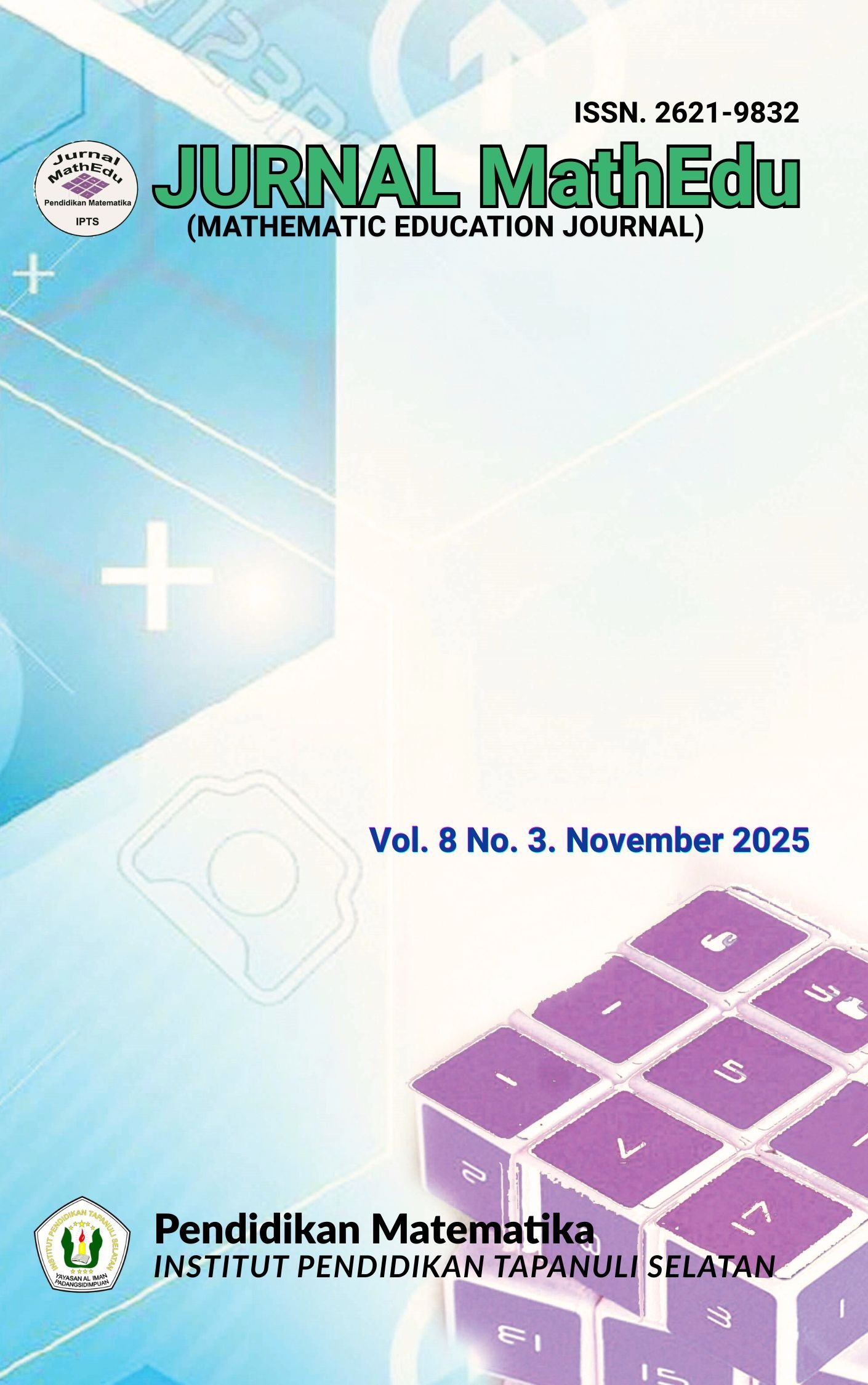PEMANFAATAN GEOGEBRA DALAM PEMBELAJARAN MATEMATIKA: STUDI IMPLEMENTASI PBL DAN TPACK PADA MATERI DIMENSI TIGA
Main Article Content
Abstract
This study aims to evaluate the effectiveness of integrating GeoGebra in mathematics
instruction through a Problem-Based Learning (PBL) model supported by the Technological
Pedagogical Content Knowledge (TPACK) framework in teaching three-dimensional geometry. The
research subjects consisted of 30 twelfth-grade science students and three mathematics teachers
from SMA Negeri 1 Sihapas Barumun, while the object of the study was the implementation process
of GeoGebra-assisted learning. A mixed-methods approach with an explanatory sequential design
was employed, combining quantitative data (tests and attitude questionnaires) and qualitative data
(observations and structured interviews). The results revealed a significant improvement in students'
conceptual understanding, with average test scores increasing from 78.5 to 87.2. Additionally, there
was a positive shift in students' affective responses, including enhanced motivation and selfconfidence, as well as increased technical and collaborative skills. In conclusion, the integration of
GeoGebra within the PBL-TPACK framework effectively enhances spatial reasoning, learning
engagement, and 21st-century skills in mathematics education.
Article Details
Authors who publish with this journal retain copyright to their articles. However, they grant the journal the right of first publication with the work simultaneously licensed under a Creative Commons Attribution License that allows others to share the work with an acknowledgment of the work's authorship and initial publication in this journal.
References
Arikunto, S. (2019). Prosedur Penelitian: Suatu Pendekatan Praktik. Rineka Cipta.
Azwar, S. (2016). Reliabilitas dan Validitas. Pustaka Pelajar.
Creswell, J. W., & Plano Clark, V. L. (2018). Designing and Conducting Mixed Methods Research
(3rd ed.). SAGE Publications.
Fajriadi, D., Priyadi, R., & Rahayu, D. V. (2022). Pengembangan media pembelajaran GeoGebra
Book materi dimensi tiga. Teorema: Teori dan Riset Matematika, 7(2), 453–466.
https://doi.org/10.25157/teorema.v7i2.8813
Hmelo-Silver, C. E. (2004). Problem-based learning: What and how do students learn? Educational
Psychology Review, 16(3), 235–266.
Lincoln, Y. S., & Guba, E. G. (1985). Naturalistic Inquiry. SAGE Publications.
Miles, M. B., Huberman, A. M., & Saldaña, J. (2014). Qualitative Data Analysis: A Methods
Sourcebook (3rd ed.). SAGE Publications.
Mishra, P., & Koehler, M. J. (2006). Technological pedagogical content knowledge: A framework
for teacher knowledge. Teachers College Record, 108(6), 1017–1054.
Nasrulloh, M., & Sugandi, A. I. (2023). Pengembangan bahan ajar materi geometri dimensi tiga
dengan menggunakan pendekatan saintifik berbantuan GeoGebra. JPMI (Jurnal Pembelajaran
Matematika Inovatif, 6(4), 1747–1756.
Rahmawati, I., & Yunita, W. (2020). Problem-based learning untuk meningkatkan kemampuan
pemecahan masalah matematis dengan bantuan GeoGebra. Jurnal Pendidikan Matematika dan
Sains, 8(1), 33–41.
Rusman. (2017). Model-Model Pembelajaran: Mengembangkan Profesionalisme Guru. Rajawali
Pers.
Santoso, S. (2021). Menguasai Statistik dengan SPSS 26. Elex Media Komputindo.
Savery, J. R. (2006). Overview of problem-based learning: Definitions and distinctions.
Interdisciplinary Journal of Problem-Based Learning, 1(1), 9–20.
Supriyadi, T., Hidayat, W., & Pratiwi, W. (2023). Pengaruh media GeoGebra terhadap kemampuan
penalaran matematis. Jurnal Didaktik Matematika, 10(2), 112–120.
Utami, I., & Firman, H. (2019). Hubungan kompetensi TPACK guru dan aktivitas belajar digital.
Jurnal Pendidikan Sains Indonesia, 7(1), 23–34.
Widyastiti, M., Yanti, Y., Sumarsa, A., & Durrotul Faizah, L. (2024). Utilization of GeoGebra
application as learning media in learning the three-dimensional to increase students' interest in
learning. Hipotenusa: Journal of Mat

